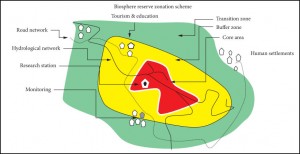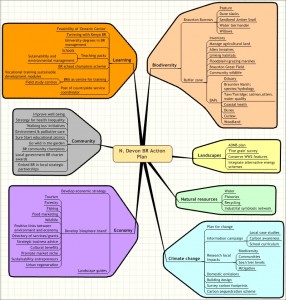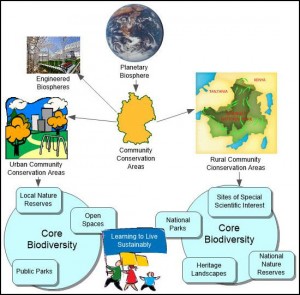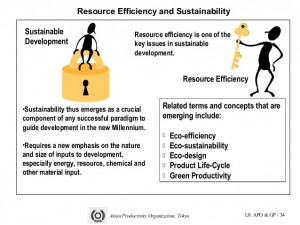1 Man and the biosphere
Fig 1 Summary of UNESCOs Man and the Biosphere Programme
UNESCO’s ‘Man and the Biosphere’ programme (MAB) proposes an interdisciplinary research agenda and education for capacity building aimed at improving the relationship of people, as citizens, with their local environment viewed as community capital in a global context. Launched in the early 1970s, the programme targets mass consumerism through the ecological, social and economic dimensions of biodiversity loss with conservation management to counteract this loss. It uses its World Network of Biosphere Reserves for knowledge-sharing, research and monitoring, education and training, and participatory decision- making in plans for sustainability.
MAB was launched in 1970 and initiated work in 14 Project areas covering different ecosystem types from mountains to the sea, from rural to urban systems, as well as more social aspects such as environmental perception. MAB’s work over the years has concentrated on the development of the World Network of Biosphere Reserve Areas.
2 Biosphere Reserve Areas
Biosphere Reserve Areas were the outcome of the “Biosphere Conference” organized by UNESCO in 1968. This was the first intergovernmental conference examining how to reconcile the conservation and use of natural resources, thereby foreshadowing the present-day notion of sustainable development. This Conference resulted in the launching of the UNESCO MAB Programme in 1970. One of the original MAB projects consisted in establishing a coordinated world network of sites representing the main ecosystems of the planet in which genetic resources would be protected, and where research on ecosystems as well as monitoring and training work could be carried out. These sites were named “Biosphere Reserves”, in reference to the MAB programme itself. Sub sectors of Earth’s biosphere, which were geographically and governmentally distinct, were to be eligible for biosphere reserve area status.
The biosphere reserve concept was developed initially in 1974 and was substantially revised in 1995 with the adoption by the UNESCO General Conference of the Statutory Framework and the Seville Strategy for Biosphere Reserves. Between these two dates, ‘Our Common Future’, also known as the Brundtland Report, from the United Nations World Commission on Environment and Development, was published (1987). Its targets were multilateralism and interdependence of nations in the search for a sustainable development path.
Today, with more than 600 sites in over 100 countries, the network provides context-specific opportunities to apply scientific knowledge about conservation of natural resources to planning at all levels, from government to community, with the objectives of:
- Reducing biodiversity loss
- Improving livelihoods
- Enhancing social, economic and cultural conditions for environmental sustainability
UNESCO Biosphere Reserve Areas (BRAs) are centred on species-rich, core protected sites. The high level of core biodiversity requires conservation management of habitats and species and which integrates cultural values of traditional natural resource management systems. The objective is to emulate the conservation management system for the core protected sites in the biosphere area, applying its logic to the management of ecosystem services in surrounding homes, businesses and community organisations for living sustainably.
The UNESCO BRAs are generally large rural areas, with most of the core in a semi natural condition under sustainable natural resource management. One of the main features of the surrounding buffer area is the low-level, non-industrial use of natural resources compatible with the principles of management for nature conservation. The BRA concept is presented diagramatically in Fig 2.
Fig 2 Pantanal model of a biosphere reserve area
The local adoption of the BRA model of UNESCO’s MAB Programme reflects a shift towards more accountable conservation and the creation of conservation communities. The programme evolved to put communities first with regards maintenance of their ecosystem services, which may be far removed in distance from the BRA. In attempting to reconcile environmental protection with sustainable development BRAs explicitly acknowledge humans, and human interests in the global conservation landscape while still maintaining the ecological values of locally protected areas upon which they are aesthetically and scientifically focussed. Thus the biosphere reserves contribute to the pursuit of the Millennium Development Goals, in particular MDG 7 on environmental sustainability. Conceptually, this model is attractive. Yet the practical reality of implementing dual ‘conservation’, ‘development’, ‘educational’ and ‘research’ goals, based on the local conservation management system of the core’s biodiversity, is challenging, with few examples successfully conforming to the model’s full criteria.
2 Time for a rethink?
Since its inception in 1968 the Biosphere Reserve programme has only recruited a few hundred reserves into its portfolio, which prompts the question, What is its present day value? This question was at the heart of a paper published in 2013 by L Kaera and colleagues entitled ‘Reviewing Biosphere Reserves globally: effective conservation action or bureaucratic label?
For a start, UNESCO BRAs are too few and far between to influence most people. More importantly, by emphasising that only a few places are special, the official designation of a BRA by UNESCO inevitably downgrades most of the places inhabited by people, mainly urban dwellers, whose biodiversity does not attain the status of a National Park, or a National Nature Reserve. In this respect, the use of the term ‘reserve’ to describe a geographical area signals that protectionism is the major objective of the designation. Indeed, this was the original basis of the biosphere idea five decades ago and although there has been a shift to stress their role to educate the local population for living sustainably, the high biodiversity core tends to be managed in isolation. On paper, biosphere reserves appear more like the ‘transition’ communities which emerged to define towns in the UK that were moving towards economic self-sufficiency in 2006. However, having a low biodiversity is not a barrier to joining the Transition Towns network.
Therefore, to get more people to embrace plans for living sustainably it is very important to adopt a wider definition of community outside the UNESCO scheme to include those centred on urban parks, open spaces and local nature sites, using their management plans as urban conservation models. In this context, the local designations of ‘Conservation Communities’ would integrate plans for living sustainably in home and neighbourhood with management of their biodiversity assets. In this wider nature conservation context the objectives of the Conservation Community would be similar to those of a biosphere reserve, namely:
- To promote sustainable use of natural resources, considering ecological, economic and social dimensions;
- To promote social and economic benefits to local communities where relevant;
- To facilitate inter-generational security for local communities’ livelihoods – therefore ensuring that such livelihoods are sustainable;
- To integrate other cultural approaches, belief systems and world-views within a range of social and economic approaches to nature conservation;
- To contribute to developing and/or maintaining a more balanced relationship between humans and the rest of nature;
- To contribute to sustainable development at national, regional and local level (in the last case mainly to local communities and/or indigenous peoples depending on the protected natural resources);
- To facilitate scientific research and environmental monitoring, mainly related to the conservation and sustainable use of natural resources;
- To collaborate in the delivery of benefits to people, mostly local communities, living in or near to the designated protected area;
- To facilitate recreation and appropriate tourism.
These objectives would be the basis of a comprehensive community action plan, like that produced by the UK’s first Biosphere Reserve (Fig 3). In this respect, conservation communities have the aim of encouraging people to get involved with the management of these functions and replicate them as exemplars to other communities following a similar pathway.
Fig 3 http://www.culturalecology.info/version2/Manandthebiosphere.html
A community conservation management system is needed that is open, integrative, evolving and adaptive, in order for the local community to better respond to external political, economic and social pressures, which would affect the ecological and cultural values of the area. This can best be achieved through organising the community system of ‘people and environment’ as an interdisciplinary knowledge framework of cultural ecology. Cultural ecology then opens up routes to engage people with:
- managing consumerism to reduce inequalities;
- managing resources to improve livelihoods;
- managing resources for environmental sustainability;
As a process of enablement, the aim of cultural ecology is to encourage people to create self-made knowledge maps to position themselves within local and national plans for sustainability in work, school, community, neighbourhood and home. The practical objective of cultural ecology is to promote managerial solutions to reconcile the conservation of biodiversity with its sustainable use. Therefore, involvement in making and operating a management plan, presenting local issues in their wider interdisciplinary aspects of a Conservation Community, promotes both local and global citizenship
Fig. 4 highlights the mutual interdependencies within Conservation Communities between land cover, land use and biodiversity to support human well-being. The various components of biodiversity (at the individual, population and community levels) and the ecological services that they provide have a central place in the emerging understandings of how people and ecosystems are connected, through land use and land cover. The physical aspect of land cover depends on, and is influenced by, the uses to which land is put and its biodiversity. Similarly the range of potential uses that an area of land can support constrains its contribution to human well-being.
Fig 4 Connections between well-being and ecosystem functions.
Where:
- Land cover is the physical characteristics of the land surface determined by both its biological and physical features.
- Land use is determined by the purposes of active and passive management of land by people and the material non-material benefits they derive from it.
- Biodiversity is the variety of ecological elements present in a place(genes, species, communities and habitats,etc.).
- Land and ecosystem functions are the potentials or capacities that land and ecosystems have to generate useful outputs for people.
- Ecosystem services are the specific and final contributions that ecosystems make to human well being.
3 Categorisation of ‘community conservation areas’ (CCAs)
As an important historical definition, the term “biosphere” was coined by the geologist Eduard Suess in 1875 as the global sum of all Earth’s ecosystems. It is the zone of life on Earth; the planetary ecosystem which integrates all living beings and their relationships, including their interaction with Earth’s distinct zonal elements of lithosphere, geosphere, hydrosphere and atmosphere. Earth’s biosphere is postulated to have evolved, beginning with a process of biogenesis at least some 3.5 billion years ago.
In a more general sense, ‘community conservation areas’ are any spaces with a well defined boundary, enclosing distinct habitats and species, which are maintained through some kind of conservation management system where local biodiversity and community plans for living sustainably come together. This includes engineered biospheres for education and research (Fig 5).
Fig 5 Categorisation of community conservation areas
In 2008, for the first time in history, the world’s urban population outnumbered the rural population. This milestone marked the advent of a new ‘urban millennium’ and, by 2050, it is expected that two-thirds of the world population will be living in urban areas. With more than half of humankind living in cities and the number of urban residents growing by nearly 73 million every year, it is estimated that urban areas account for 70 per cent of the world’s gross domestic product and has therefore generated economic growth and prosperity for many.
The 2030 Agenda for Sustainable Development tackles this challenge through its Sustainable Development Goal 11, which aims to “make cities and human settlements inclusive, safe, resilient and sustainable”. This has been taken up by planners to design new transition economies.
The concept of the transition economy has gained currency to a large extent because it provides a response to the multiple crises that the world has been facing in recent years – the climate, food and economic crises – with an alternative paradigm that offers the promise of growth while protecting the earth’s ecosystems and, in turn, contributing to poverty alleviation. In this sense, the transition will entail moving away from the system that allowed, and at times generated, these crises to a system that proactively addresses and prevents them. There is no unique definition of the transition economy, but the term itself underscores the economic dimensions of sustainability or, in terms of the recent UNEP report on the ‘Green Economy’, it responds to the “growing recognition that achieving sustainability rests almost entirely on getting the economy right”. It also emphasizes the crucial point that economic growth and environmental stewardship can be complementary strategies, challenging the still common view that there are significant tradeoffs between these two objectives – in other words, that the synergies prevail over the tradeoffs. This underscores a view that the concept of transition economy should be seen as consistent with the broader and older concept of sustainable development.
The specificities of the broader concept are its holistic character, as it encompasses the three pillars of development – economic, social and environmental – and its particular focus on inter-generational equity. This is reflected in UNEP’s definition of a green economy as “one that results in improved human wellbeing and social equity, while significantly reducing environmental risks and ecological scarcities”. Indeed, growing urbanization can be a plus for the environment, because people who live in dense cities drive less, their living spaces use less energy, and they require fewer resources. But there are also troubling trends, like increased traffic congestion, smog, and blight. Beijing’s per-capita greenhouse gas emissions are higher than China’s national average, and many U.S. cities are surrounded by suburbs with large carbon footprints. On the other hand cities are hubs for ideas, commerce, culture, science, productivity, social, human and economic development. Urban planning, transport systems, water, sanitation, waste management, disaster risk reduction, access to information, education and capacity-building are all relevant issues a programme of transitional urban development.
“Promoting sustainable human settlements development” is the subject of Chapter 7 of Agenda 21, which calls for
- providing adequate shelter for all;
- improving human settlements management;
- promoting sustainable land-use planning and management;
- promoting the integrated provision of environmental infrastructure: water, sanitation, drainage and solid waste management;
- promoting sustainable energy and transport systems in human settlements;
- promoting human settlements planning and management in disaster-prone areas;
- promoting sustainable construction industry activities; and 8) promoting human resource development and capacity-building for human settlements development.
These issues are the targets for, urban conservation communities in transition (Fig 6).
Fig 6 Conceptual model of an urban biosphere reserve area

4 Who is going to be the first to blink?
Natural Capital can be defined as the world’s stocks of natural assets, which include rocks, soil, air, water and all living things. It is from this natural capital that humans derive a wide range of services, often called ecosystem services, which make human life possible.
The term natural capital implies an extension of the economic notion of capital. Just as all forms of capital are capable of providing a flow of goods and services, components of natural capital interact to provide humans and other species with goods and services that are wide-ranging and diverse. The collective benefits provided by the resources and processes supplied by natural capital are known as ecosystem goods and services, or simply ecosystem services. These services are imperative for survival and well-being. They are also the basis for all economic activity.
The most obvious ecosystem services include the food we eat, the water we drink and the plant materials we use for fuel, building materials and medicines. There are also many less visible ecosystem services such as the climate regulation and natural flood defences provided by forests, the billions of tonnes of carbon stored by peatlands, or the pollination of crops by insects. Even less visible are cultural ecosystem services such as the inspiration we take from wildlife and the natural environment.
In practical terms, a biosphere reserve area represents community capital for understanding how to integrate land cover, land use and biodiversity to support long-term human well-being. The management plan for conserving its core biodiversity is actually a model for meeting the goals of the 1992 ‘Report of the The United Nations Conference on Environment and Development (the Rio environment summit). Chapter 2 deals with promoting sustainable development through trade and making trade and environment mutually supportive. In the latter area it summarised the basis for action as follows:
“Environment and trade policies should be mutually supportive. An open, multilateral trading system makes possible a more efficient allocation and use of resources and thereby contributes to an increase in production and incomes and to lessening demands on the environment.
Agenda 21 sees environmental protection as the key to sustainable development. On the other hand the report says that a sound environment provides the ecological and other resources needed to sustain growth and underpin a continuing expansion of trade. We can’t have it both ways because in the end, Earth’s natural resources are not limitless.
When Karl Marx spoke of religion as the opiate of the masses he might well have been referring to the catechism of contemporary economic theology that an expanding economic pie will bring universal prosperity to everyone. This widely espoused article of faith then becomes the foundation of arguments for a whole range of policies to sustain economic growth, that almost invariably favour the strong over the weak.
A simple bit of arithmetic demonstrates the point. Let us assume that the call of the Brundtland Commission for a global growth rate of 3% without redistribution were to be realized. In ten years time the average Ethiopian would be earning an additional $41. The average American would enjoy an additional $7,257.20
Without concurrent redistribution, an expanding pie brings far greater benefit to the already wealthy than to the poor, increases the gap between rich and poor, and increases the power advantage of the former over the latter. This advantage becomes a life and death issue in a resource scarce world in which the rich and poor are locked in mortal competition for a depleting resource base. In both scenarios, there is no doubt that we need to use natural resources more efficiently, a change in approach known as dematerialisation (Fig 7).
Fig 7 Increased efficiency of resource utilisation is key to living sustainably
Friedrich Schmidt-Bleek, from the Wuppertal Institute for Climate, Environment and Energy, first proposed the dematerialisation concepts in the early 1990s. He concluded that 80% of the world’s resources are distributed among ‘First World nations’, which contribute 20% of the global population, so those nations are prompting an unsustainable system of development. Six years after the Rio Environment Summit, Hunter and Amory Lovins of the Rocky Mountain Institute, and Ernst von Weizsäcker, founder of the Wuppertal Institute, published ‘Factor 4’, a book that explains how relatively easy it is for businesses to operate more efficiently with existing technologies. It has many examples of real-world projects that save money and reduce pollution simultaneously.
The goal of being twice as productive with half the resources (materials and energy), leads to a factor 4 improvement in efficiency. Alternatively, practices which are just as productive with 1/4 of the resources or 4 times as effective with the same resources, also count. Another way of phrasing the Factor 4 efficiency gain is that it reduces energy and materials usage by 75%.
While ‘Factor Four’ is a common term representing a minimum four-fold increase in economic efficiency for transition plans, ‘Factor Ten’–ten times as much productivity from the same inputs (ranging to the same productivity with 1/10th the resources)–represents an even greater challenge. ‘Factor Ten’ equates to a 90% decrease in resource usage. ‘Factor 10’ evolved from the less dramatic ‘Factor 4’. It also requires the creation of new technologies, policies, and manufacturing processes along with sociocultural change to create a global economy that is sustainable for a long period of time.
The goal of ‘Factor 10’ is to assure that nations do not exceed the planet’s carrying capacity but leave sufficient resources for future generations. ‘Factor 10’ goes further as a response to the United Nations’ Environment Programme call for a tenfold reduction in resource consumption in industrialised countries as a necessary long-term target if adequate resources are to be released for the needs of the developing countries. With the predicted rise in population and economic growth so as not to exceed the level of pollution we have today, we need to be able to produce the same output for 10% of the impact.
In terms of which nation will be the first to adopt Factor 10 wholeheartedly, F. Schmidt-Bleek, President of the Factor 10 Institute, writing at the start of the new millennium, put it this way:
“Sustainability requires that environment and economic development be made mutually supportive at the front end of the cycle when the goals and policies are being set, not at the tail end after society has already incurred the damage costs of unsustainable development.
Dematerialization creates synergies for changing values of society, particularly in western countries. Indeed, the Factor 10 concept offers in itself a valuable stimulus and basis to advance structural change toward a more innovative and service-focussed economy and provokes sustainable consumer choices. Thus, Factor 10 emerges as a key component to guide development in the new Millennium.
Despite the prevailing uncertainties I remain convinced that if the process of dematerialization does not begin soon, both the social fabric of our societies and the global ecosystem are seriously at risk in the medium term. Furthermore, by starting now, we would have the option of achieving a transition slowly by evolution rather than being forced to change suddenly through revolution”.
Fifteen years later the world is still fixing its sights on annual growth rates that cannot be maintained!.
L Kaera and colleagues referenced the fact that continuing to emphasise ‘development’ as a core function of Biosphere Reserves is deflecting from the importance of the roles of biosphere reserve areas as ‘learning sites’ for sustainable development. That critique prompted this blog. It will be continued as comparative study of conservation communities, particularly in relation to their management plans, as a comparative concept map and wiki. The central question is how can transition communities, large and small become, established.
http://www.rootsandroutes.wikispaces.com
5 Web references
Kaera L. Coetzer∗, Edward T. F. Witkowski and Barend F. N. Erasmus
http://www.ukmaburbanforum.co.uk/docunents/papers/bio-Res_1.pdf
http://www.saiplatform.org/uploads/Library/landuse%20and%20biodiversity-2.pdf
http://eau.sagepub.com/content/18/1/51.full.pdf
http://www.ifoundbutterflies.org/personal-conservation-efforts/the-butterfly-conservatory-of-goa
http://www.anu.edu.au/factoroften/assets/factor10background.pdf
http://sedac.ciesin.columbia.edu/entri/texts/a21/a21-02-sd.html
http://livingeconomiesforum.org/economy-ecology-spirituality
http://www.uq.edu.au/marxan/docs/Lourival_etal_NC2011.pdf





